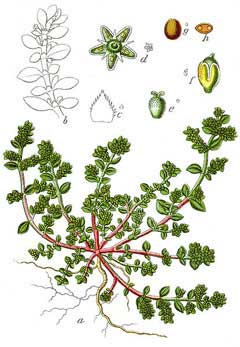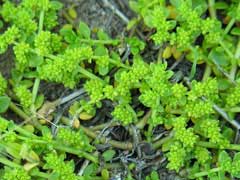 |
|
http://commons.wikimedia.org/wiki/File:Herniaria_glabra_Sturm2.jpg |
 |
| http://commons.wikimedia.org/wiki/User:JustassHerniaria hirsuta |
Translate this page:
Summary
Physical Characteristics
![]()
![]() Herniaria glabra is a BIENNIAL/PERENNIAL.
Herniaria glabra is a BIENNIAL/PERENNIAL.
See above for USDA hardiness. It is hardy to UK zone 5 and is not frost tender. It is in flower in July, and the seeds ripen in August. The species is hermaphrodite (has both male and female organs) and is pollinated by Insects. The plant is self-fertile.
Suitable for: light (sandy) and medium (loamy) soils, prefers well-drained soil and can grow in nutritionally poor soil. Suitable pH: mildly acid, neutral and basic (mildly alkaline) soils. It cannot grow in the shade. It prefers dry or moist soil and can tolerate drought. The plant can tolerates strong winds but not maritime exposure.
UK Hardiness Map
US Hardiness Map
Synonyms
Plant Habitats
Ground Cover; Cultivated Beds;
Edible Uses
References More on Edible Uses
Medicinal Uses
Plants For A Future can not take any responsibility for any adverse effects from the use of plants. Always seek advice from a professional before using a plant medicinally.
Antirheumatic Astringent Diuretic Expectorant
The whole plant, gathered when in flower, is astringent, very actively diuretic and expectorant[4, 9, 61, 240, 254]. It appears to have an antispasmodic effect upon the bladder and is used in the treatment of dropsy, catarrh of the bladder, cystitis and kidney stones[240, 254]. It has also gained a reputation for treating hernias[4, 9, 61]. Externally, it has been used as a poultice to speed the healing of ulcers[254].
References More on Medicinal Uses
The Bookshop: Edible Plant Books
Our Latest books on Perennial Plants For Food Forests and Permaculture Gardens in paperback or digital formats.

Edible Tropical Plants
Food Forest Plants for Hotter Conditions: 250+ Plants For Tropical Food Forests & Permaculture Gardens.
More

Edible Temperate Plants
Plants for Your Food Forest: 500 Plants for Temperate Food Forests & Permaculture Gardens.
More

More Books
PFAF have eight books available in paperback and digital formats. Browse the shop for more information.
Shop Now
Other Uses
Cleanser
A good ground cover plant, allowing spring bulbs to grow through it[200]. An aqueous extract of the plant is a hand cleanser, making the skin soft and supple[240].
Special Uses
Ground cover Scented Plants
References More on Other Uses
Cultivation details
Grows well in hot dry soils[1]. Dislikes excessive moisture[1]. Succeeds in very poor soils[1]. Useful for covering rocks or as a carpet bedding[1], it makes a good ground cover for spring bulbs since they can grow through it easily[200]. The leaves emit a musky smell when they are handled[245].
References Carbon Farming Information and Carbon Sequestration Information
Temperature Converter
Type a value in the Celsius field to convert the value to Fahrenheit:
Fahrenheit:
The PFAF Bookshop
Plants For A Future have a number of books available in paperback and digital form. Book titles include Edible Plants, Edible Perennials, Edible Trees,Edible Shrubs, Woodland Gardening, and Temperate Food Forest Plants. Our new book is Food Forest Plants For Hotter Conditions (Tropical and Sub-Tropical).
Shop Now
Plant Propagation
Seed - sow spring in a cold frame. When they are large enough to handle, prick the seedlings out into individual pots and grow them on in the greenhouse for their first winter. Plant them out into their permanent positions in late spring or early summer, after the last expected frosts.
Other Names
If available other names are mentioned here
Native Range
TEMPERATE ASIA: Afghanistan, Egypt (Sinai), Iran, Israel, Lebanon, Turkey, Armenia, Azerbaijan, Georgia, Russian Federation (Novosibirsk), Kazakhstan, Kyrgyzstan, Tajikistan, Uzbekistan, Mongolia, China (Sichuan Sheng (west), Xinjiang Uygur Zizhiqu (north)) EUROPE: Denmark, United Kingdom (England), Sweden (south), Austria, Belgium, Switzerland, Czech Republic, Germany, Hungary, Netherlands, Poland, Slovakia, Russian Federation (European part), Belarus, Estonia, Lithuania, Latvia, Ukraine (incl. Krym), Albania, Bulgaria, Bosnia and Herzegovina, Greece, Croatia, Italy (incl. Sicily), North Macedonia, Montenegro, Romania, Serbia, Slovenia, Spain, France (incl. Corsica), Portugal AFRICA: Algeria (north), Egypt, Libya (north), Morocco, Tunisia
Weed Potential
Right plant wrong place. We are currently updating this section.
Please note that a plant may be invasive in one area but may not in your area so it's worth checking.
Conservation Status
IUCN Red List of Threatened Plants Status :

Growth: S = slow M = medium F = fast. Soil: L = light (sandy) M = medium H = heavy (clay). pH: A = acid N = neutral B = basic (alkaline). Shade: F = full shade S = semi-shade N = no shade. Moisture: D = dry M = Moist We = wet Wa = water.
Now available:
Food Forest Plants for Mediterranean Conditions
350+ Perennial Plants For Mediterranean and Drier Food Forests and Permaculture Gardens.
[Paperback and eBook]
This is the third in Plants For A Future's series of plant guides for food forests tailored to
specific climate zones. Following volumes on temperate and tropical ecosystems, this book focuses
on species suited to Mediterranean conditions—regions with hot, dry summers and cool, wet winters,
often facing the added challenge of climate change.
Read More
Expert comment
Author
L.
Botanical References
17
Links / References
For a list of references used on this page please go here
Readers comment
| Add a comment |
|
If you have important information about this plant that may help other users please add a comment or link below. Only comments or links that are felt to be directly relevant to a plant will be included. If you think a comment/link or information contained on this page is inaccurate or misleading we would welcome your feedback at [email protected]. If you have questions about a plant please use the Forum on this website as we do not have the resources to answer questions ourselves.
* Please note: the comments by website users are not necessarily those held by PFAF and may give misleading or inaccurate information.
To leave a comment please Register or login here All comments need to be approved so will not appear immediately.
|
Subject : Herniaria glabra
|
|
|
|